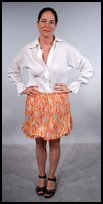|
Online Patternmaking Classes
by Don McCunn Lower Torso Sloper Home Page ► Week Three
Using the Lower Torso Sloper for SkirtsContentsThe Lower Torso Sloper can be used to create a variety of different skirts. Some examples of variations are included in my book How to Make Sewing Patterns on pages 130 to 134, 2nd ed. (pages 147 to 151, 1st ed.) If you have taken my "Introduction to Pattern Design" class, all the techniques described were developed using the skirt like example of an apron. It should be a straight forward process to applying those techniques to skirts. Skirt VariationsI am including instructions for the five skirt variations shown below. The first skirt is the sloper made in an appropriate fabric. The next two skirts illustrate the two types of fullness you can include in a skirt. The final two examples show how to convert the sloper into a skirt with a contoured waistband that can either be fitted, a Pencil skirt, or a full A-Line skirt.
Calculating Fabric Needs When you are creating an original design if you are not using fabric you already have on hand, you will need to determine how much fabric you will need. One way to do this is to create the patterns first then lay them out as if you were placing them on folded fabric. While 44 inches is a standard width for a lot of fabric, you may need to adjust the layout for different width fabric. Keep in mind that some fabric, such as velvet, is directional. You may also want to work with prints or plaids which require more yardage. One thing to keep in mind is that when you are creating your own patterns, you may change the patterns to fit the fabric you bought. I have on occasion done fullness for a skirt but then when I saw how it was going to come out on the fabric, redrafted it a little smaller. For the handkerchief skirt and the gathered skirt described above both were based on the material. The handkerchief is square so the length equals the width. For the gathered skirt, I used the material I had on hand adjusting the hem length to the fabric I had. Another option is to try out your design idea in quarter scale. Then layout those patterns and multiply by four to determine the amount of fabric you need. Adjusting for Fullness
When you are creating a skirt that has fullness, start with the maximum amount of fullness you think you will need but add extra length to the hem. Then if you need to remove some of the fullness, you will have the fabric to make the change as shown in the image below.  Resources for Design IdeasThere are a variety of resources for design ideas.
Lower Torso Sloper Home Page ► Week Three
Copyright © 2007, & 2020 by Donald H. McCunn
| ||||||||||||||||||






